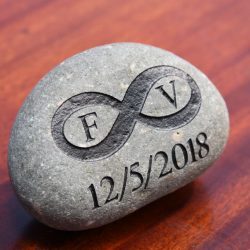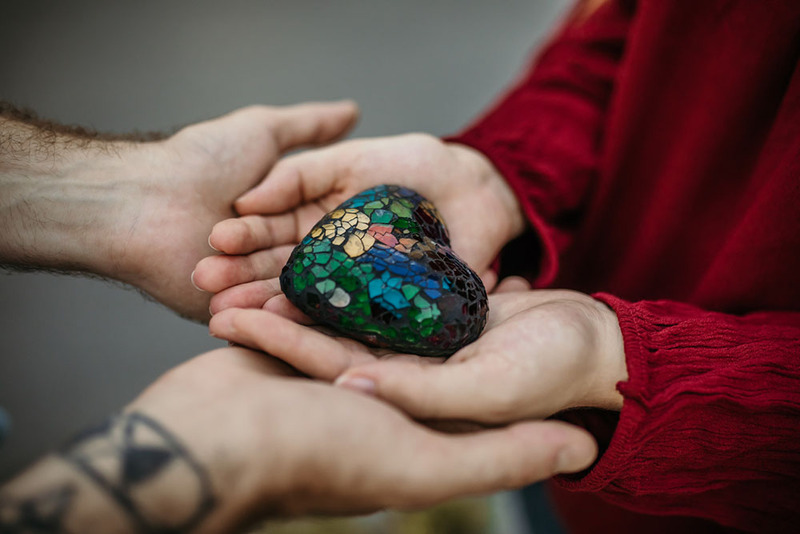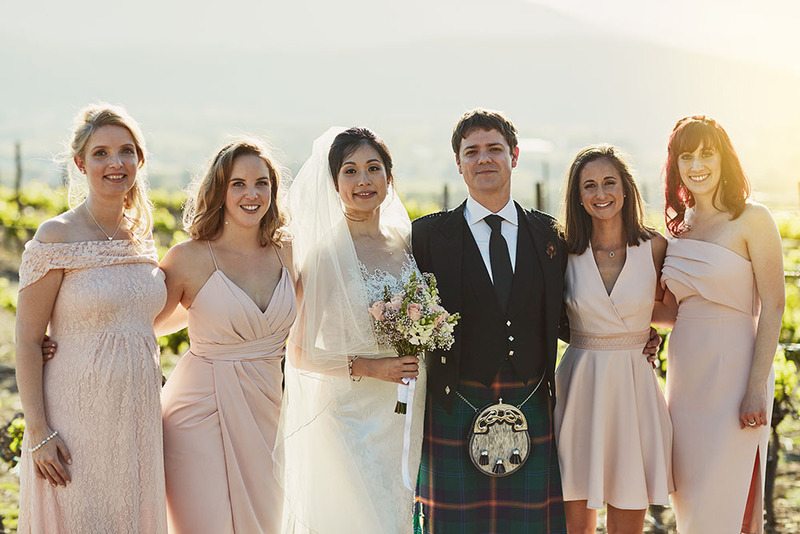AMERICAN WEDDINGS BLOG
Stay up to date with the latest wedding ceremony trends, script writing inspiration, tips and advice for first-time officiants, and news that matters to couples and wedding ministers.
Stay up to date with the latest wedding ceremony trends, script writing inspiration, tips and advice for first-time officiants, and news that matters to couples and wedding ministers.
Published Wednesday, May. 26th, 2021

Listen now:
Centuries ago in Scotland, young couples and their families would gather on the wedding day near a pond or stream, or along a rocky coastline. There, surrounded by the beauty of the natural world and the spirits and gods that resided there, the couple would clasp a special wedding 'oath stone' or 'oathing stone,' in their hands and take their vows of love and devotion -- sealing the marriage oath in stone.
Scottish wedding traditions say that taking your vows while holding an oath stone or rock makes them stronger, and that taking them near the magical forces of water made them even stronger. Couples sometimes carved a Celtic wedding knot into the oathing stone’s surface, or etch their names across it. Making wedding vows this way was called “setting an oath in stone,” and it’s probably where the modern expression ‘set in stone’ comes from. (How romantic!)
Once the couple's oath was set and the marriage vow was sealed, the couple’s wedding stone would be tossed into the water or kept in their home as a lasting symbol of their commitment. Guests at the wedding might do the same with their own special oath stones -- called blessing stones -- by tossing them into the water, or placing them into a container or garden as part of a stone blessing ceremony. See the article linked below to learn more:

A beautiful example of an oath stone, used in the oathing stone ceremony. This photo is courtesy of Perfect Images, via via Argyll and Bute Council, Scotland.
The Oathing Stone Ceremony is still a popular unity ritual in Scottish wedding ceremonies, and in weddings all across Europe and throughout the U.S. as a way for couples to pledge their lasting love. As modern couples search for new ways to personalize their ceremony with unique unity rituals, wedding officiants can expect to see the oathing stone custom (or its counterpart -- the stone blessing ceremony) more often.
Because the Oathing Stone Ceremony doesn’t belong to any particular religion or region, it’s easy to modify to fit any style of wedding, and to align with any spiritual meaning or personal significance. This makes it a versatile choice for religious or non religious weddings, ‘spiritual but not religious’ weddings, Pagan weddings, formal ceremonies, simple outdoor elopements, and everything (and anything!) in between.
This simple outline and sample script will help you get started planning or officiating an oathing stone ceremony. Change what you need to to make it work for you, and combine it with other rituals (like a handfasting ceremony) or a special reading to make it more personal and meaningful.
Most importantly, have fun with it!

Choose any kind of stone for your oathing stone ritual! Traditionally, an oath stone is carved with a Celtic wedding knot, your initials, or your wedding date, but modern oath stones can be any color or design you wish to represent your unique love. (Photo: Handsome Bob / iStock)
For Couples: First, choose an oathing stone! You can purchase an oathing stone from a local artist or online shop, or pick one up at your favorite outdoor spot -- such as a state park or forest, vacation spot, or beach. Or get creative: some couples choose to use a stone sculpture or carved art piece instead.
Your oathing stone can be any size, shape, texture, or color you wish, but choose a stone that's smooth and flat if you plan to add a design -- one that’s suitable for carving or etching.
Clean the stone and let it dry thoroughly. This might take a day or two. Then polish it with a natural oil, such as almond oil or linseed oil to add a bright shine. But remember! Oil will bring out the natural texture of the stone, but it will also change and darken the surface color of the stone.
The Oathing Stone Ceremony is often combined with the couple's Exchange of Wedding Vows. You'll place your hands on the oathing stone as you say your wedding vows, symbolically sealing your promises in stone.
For the Wedding Officiant: At the start of the Vow Exchange, ask the best man or maid of honor (or whoever’s in charge of the stone) to step forward. They'll hand the oathing stone to the couple, or place it on a small table nearby.
You'll instruct the couple to hold the stone in their hands (or rest their hands on it) as they say their wedding vows. This unity ritual might work best with 'repeat after me vows' or a simple Declaration of Intent, so that your couple doesn't have to juggle a vow booklet or note card to read written vows -- but feel free to get creative!
After the exchange of vows, intruct the couple to return the oath stone to attendant, or have them throw it into the water to seal the blessing (as part of the traditional Scottish wedding tradition).
If the unity ritual is combined with a Blessing Stone Ceremony or traditional Irish Blessing Stones, ask guests to add their stones to the vase or container the couple’s chosen, or to toss them into the water. (This might be a wishing well, river, ocean, etc.)
Keep reading for a sample Oathing Stone Ceremony Script for wedding officiants!

For the Wedding Officiant: Use this unity ceremony script as a starting place, and personalize it to suit your couple and their style. The most important thing to remember is that some of the guests won’t be familiar with this type of ceremony, and might not understand what’s happening, or why, so you will want to explain what is happening before the couple makes their vows.
In a sentence or two, tell the guests why the couple chose this unique unity ceremony and what it symbolizes to them. If the oathing stone carries a special connection to a place or region, share that too, along with any relevant history or cultural significance. Include any details they might need to know in order to participate or feel included in the ceremony.
Officiant:
“Friends and loved ones, ___________ and ___________ will now take their vows with a traditional Scottish oathing stone, symbolizing the lasting quality of their love.
___________, please step forward with the stone."
[The best man, maid of honor, or honored guest will step forward and hand the stone to the couple, who hold it between them.]
"For those not familiar with this tradition -- love sworn over a stone strengthens a bond, and connects two people with the wisdom of the past and love of their families.
___________ and ___________, you chose this stone during a long, laughter-filled hike in the Blue Ridge Mountains -- one that ___________ later described to your friends as ‘comically heroic.” It represents your sense of adventure, your appreciation for time spent exploring the world together, your ability to always rely on each other -- and ___________’s sense of direction -- and the rock-hard strength of your love.
As you join in marriage today, let this stone represent a lasting foundation, grounded in the past as you look to the future.
___________ , do you promise to love and respect ___________ for the days and years to come, supporting them through good and bad, and welcoming each day and each opportunity together with honesty, humor, and faith?”
Partner One: “I do!”
Officiant:
“And ___________ , do you promise to love and respect ___________ for the days and years to come, supporting them through good and bad, welcoming each day and each opportunity together with honesty, humor, and faith?”
Partner Two: “I do!”

Once the couples vows have been made, the couple hands the stone back (until the ceremony is complete), places it on the wedding altar, or tosses it into the water. If the ceremony is part of a traditional Irish Blessing Stones ceremony, guests can toss their stones into the water now too, with direction from the officiant.
As you can see, this timeless wedding custom offers plenty of creativity and versatility, whether the couple is looking for something traditional or entirely unconventional. Because it gives the couple a chance to share their story with guests in a unique way, we’ll likely see more of it for years to come!
Handfasting: From Ancient Rituals to Modern Ceremonies
An illustrated guide to handfasting

Plan a unique handfasting ceremony with this one of a kind illustrated guide! Filled with interesting handfasting history, ancient lore, and helpful handfasting 'how to' tips, this modern handfasting guide is the perfect start to your ceremony.
Written and illustrated by Jessica Levey, this book is filled with colorful illustrations, Pagan wedding history and imagery, and sample handfasting ceremony scripts for the wedding officiant.
Good things happen when friends and relatives help out at the wedding ceremony! Having a friend officiate your wedding is a great way to ensure the wedding day is as intimate and personal as it can be. When a loved one officiates, every moment means more.
Ask a friend or family member to officiate your wedding with free online ordination through American Marriage Ministries (AMM).
|* custom-button, "https://theamm.org/ordination-application", "ORDAINED MINISTER ONLINE APPLICATION" *|
Why AMM? American Marriage Ministries is an inclusive nondenominational internet church that ordains and trains ministers to officiate marriage ceremonies. We are a recognized 501(c)(3) nonprofit church, and help people from all backgrounds and beliefs become ordained ministers for weddings. Our online ordination is free, accessible, and never expires.
Officiating weddings is an incredible honor, and a great way to show your love and support for the people getting married. As a wedding officiant, you will help to create memorable ceremonies and memories that last a lifetime.
AMM Ministers can legally officiate weddings in every state* (it's much harder in Virginia, where we're looking into our options). After getting ordained with AMM, you might need to register your ordination with your local county clerk’s office. Click the link above to get started!

Become an ordained minister online with American Marriage Ministries and officiate wedding for friends and relatives. (Photo: SometimesNever/peopleimages.com / Adobe Stock)
Become a Wedding Officiant with Our Free Online Ordination!